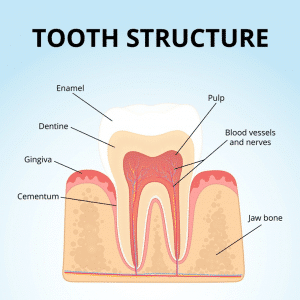What Happens During a Root Canal Treatment?
Root Canal Therapy is a form of dental procedure that is primarily concerned with treating any disease process related to the pulp of the tooth.
The pulp of the tooth is critical in the early development of the tooth. Often during its development or once the tooth has matured the pulp can get injured which leads to it becoming inflamed or infected.
Common causes of damage to the pulp include:
- Deep decay due to untreated caries
- Multiple restorative procedures on the same tooth
- A crack in the tooth
- Traumatic injury to the tooth
Dental 359’s Procedure for Root Canal Treatment
Appointment 1- Pulp Extirpation (Safe removal of the injured pulp)
Extirpation is the safe and effective removal of the inflamed portion of the pulp. This is often carried out as an emergency procedure when a patient presents in acute pain. The steps may include
Step 1. Anaesthetic
The Dentist will apply a topical anaesthetic to the gums to numb the area before using local anaesthetic to ensure you will minimal to no discomfort during the procedure.
Step 2. Place the rubber dam
An isolation device called a rubber dam will be placed on the tooth being treated. This facilitates a clean and dry working field to obtain optimal clinical results while protecting your away and minimising debris and fluids you need to swallow.
Step 3. Access and Removing the Pulp
To access the pulp a small access will be made by the Dentist at the top of the tooth. Through the access the infected or damaged pulp will be removed carefully from all the canals.
Step 4. Antibiotics
Once the pulp is removed the dentist will irrigate and dry the canals. Once dry they will place an effective antibiotic to further sterilise the tooth and prevent ongoing infections.
Step 5. Temporary filling
A soft cotton pellet and sealant is placed over the canals. While sealing up the access and avoiding any contamination via salivary bacteria this also facilitates the repeat access into the root canal system as and when needed
Appointment 2- Canal shaping and further disinfection.
The root canal anatomy and shapes can be quite complex and convoluted. This step of shaping and accessing most of this complex network allows for a thorough disinfection of the tooth while preserving healthy tooth structure. The steps may include
Step 1. Anaesthetic
The Dentist will apply a topical anaesthetic to the gums to numb the area before using local anaesthetic to ensure you will minimal to no discomfort during the procedure.
Step 2. Place the rubber dam
The isolation device called a rubber dam will be placed on the tooth being treated.
Step 3. Working length measurement
Once the canals are accessed through the temporary restoration the dentist will proceed to measure each canal to ensure they can clean out the full length of the root canal. This will either be done via an electronic instrument or via digital radiography.
Step 4. Shaping the canals.
Each of the canals will now be shaped and prepared sequentially. As mentioned before this allows for a more effective cleansing of the root system and more effective sealing of the canals.
Step 3. Antibiotics
Once the canals are shaped the dentist will irrigate and dry the canals. Once dry they will place an effective antibiotic to further sterilise the tooth and prevent any on-going infections.
Step 5. Temporary filling
A soft cotton pellet and sealant is placed over the canals. While sealing up the access and avoiding any contamination via salivary bacteria this also facilitates the repeat access into the root canal system as and when needed. This is the END of the first appointment.
Appointment 3 – Obturation (Sealing the root canal system)
This appointment involves the long term sealing of the root canal system with a biologically inert root filling material which is designed to stop the introduction of bacterial into the root canal system.
Step 1. Anaesthetic
The Dentist will apply a topical anaesthetic to the gums to numb the area before using local anaesthetic to ensure you will minimal to no discomfort during the procedure.
Step 2. Place the rubber dam
The isolation device called a rubber dam will be placed on the tooth being treated.
Step 3. Root canal obturation (placing the Gutta Percha seal)
Once again the dentist will access the root canal system via the temporary restoration. After thoroughly washing and drying the canals they will be ready to seal it.
A rubber-like root filling material (called gutta percha) is used to fill the canals. This is a thermoplastic material (‘thermo’ meaning heat and ‘plastic’ meaning shape) that is heated and then compressed into and against the root canal walls to seal them.
The gutta-percha is used in combination with a root canal sealer. The sealer is utilised as a lubricant and binding agent to eliminate any spaces within the canal where the gutta-percha may not be able to penetrate.
The temporary filling will then be replaced until the final restoration is cemented.
A final digital radiograph will be taken to review the treatment.
Appointment 4- Final restoration
The final step involves restoring the tooth. This step is critical to ensure the structural integrity of the tooth is reinforced and the root system is effectively sealed. The type of restoration required will depend on the amount of structural damage to the tooth, but may include a resin restoration, crown, or crown with a post and/or core.
Find out more about resin restorations.
Find out more about dental crowns.
We asked one of Dr Golestani’s patients to provide feedback following his root canal treatment.
This is what Suraj had to say about his experience.
“My experience at Dental 359 Clinic will be one to remember. I was in an unbearable pain for a while, but left the clinic feeling completely relieved from my very first visit.
The staffs has always been amazing and I was well looked after throughout the whole process. The care I received for my root canal treatment was extremely satisfying, it was truly professional and I would highly recommend anyone to visit them for a painless treatment, especially for root canals.”
If you would like to arrange an appointment with our team please phone 1300 625 625 to speak with one of our friendly Treatment Coordinators.











